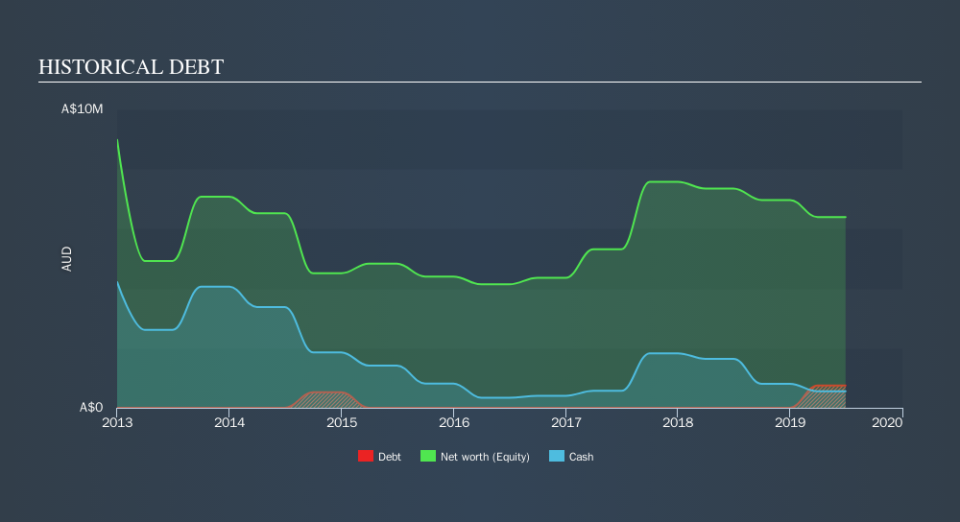Here's Why Norwest Energy (ASX:NWE) Can Afford Some Debt

The external fund manager backed by Berkshire Hathaway's Charlie Munger, Li Lu, makes no bones about it when he says 'The biggest investment risk is not the volatility of prices, but whether you will suffer a permanent loss of capital. It's only natural to consider a company's balance sheet when you examine how risky it is, since debt is often involved when a business collapses. Importantly, Norwest Energy NL (ASX:NWE) does carry debt. But is this debt a concern to shareholders?
What Risk Does Debt Bring?
Debt is a tool to help businesses grow, but if a business is incapable of paying off its lenders, then it exists at their mercy. Ultimately, if the company can't fulfill its legal obligations to repay debt, shareholders could walk away with nothing. However, a more usual (but still expensive) situation is where a company must dilute shareholders at a cheap share price simply to get debt under control. By replacing dilution, though, debt can be an extremely good tool for businesses that need capital to invest in growth at high rates of return. The first thing to do when considering how much debt a business uses is to look at its cash and debt together.
Check out our latest analysis for Norwest Energy
How Much Debt Does Norwest Energy Carry?
As you can see below, at the end of June 2019, Norwest Energy had AU$750.0k of debt, up from none a year ago. Click the image for more detail. However, it also had AU$553.3k in cash, and so its net debt is AU$196.8k.
How Strong Is Norwest Energy's Balance Sheet?
The latest balance sheet data shows that Norwest Energy had liabilities of AU$244.5k due within a year, and liabilities of AU$760.3k falling due after that. Offsetting this, it had AU$553.3k in cash and AU$79.5k in receivables that were due within 12 months. So its liabilities outweigh the sum of its cash and (near-term) receivables by AU$372.1k.
Since publicly traded Norwest Energy shares are worth a total of AU$16.9m, it seems unlikely that this level of liabilities would be a major threat. But there are sufficient liabilities that we would certainly recommend shareholders continue to monitor the balance sheet, going forward. Carrying virtually no net debt, Norwest Energy has a very light debt load indeed. There's no doubt that we learn most about debt from the balance sheet. But you can't view debt in total isolation; since Norwest Energy will need earnings to service that debt. So if you're keen to discover more about its earnings, it might be worth checking out this graph of its long term earnings trend.
Since Norwest Energy doesn't have significant operating revenue, shareholders must hope it'll sell some fossil fuels, before it runs out of money.
Caveat Emptor
Importantly, Norwest Energy had negative earnings before interest and tax (EBIT), over the last year. Indeed, it lost AU$882k at the EBIT level. When we look at that and recall the liabilities on its balance sheet, relative to cash, it seems unwise to us for the company to have any debt. Quite frankly we think the balance sheet is far from match-fit, although it could be improved with time. However, it doesn't help that it burned through AU$1.1m of cash over the last year. So in short it's a really risky stock. When we look at a riskier company, we like to check how their profits (or losses) are trending over time. Today, we're providing readers this interactive graph showing how Norwest Energy's profit, revenue, and operating cashflow have changed over the last few years.
At the end of the day, it's often better to focus on companies that are free from net debt. You can access our special list of such companies (all with a track record of profit growth). It's free.
We aim to bring you long-term focused research analysis driven by fundamental data. Note that our analysis may not factor in the latest price-sensitive company announcements or qualitative material.
If you spot an error that warrants correction, please contact the editor at editorial-team@simplywallst.com. This article by Simply Wall St is general in nature. It does not constitute a recommendation to buy or sell any stock, and does not take account of your objectives, or your financial situation. Simply Wall St has no position in the stocks mentioned. Thank you for reading.

 Yahoo Finance
Yahoo Finance 
